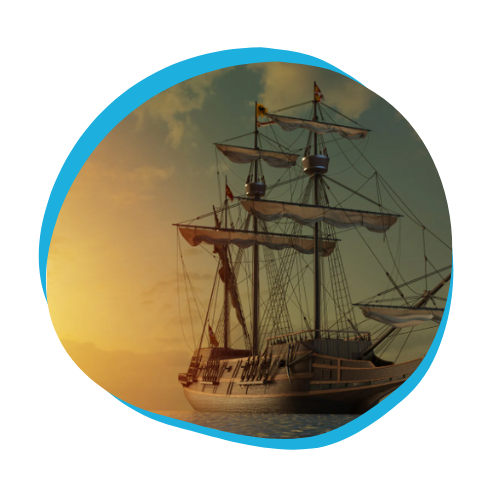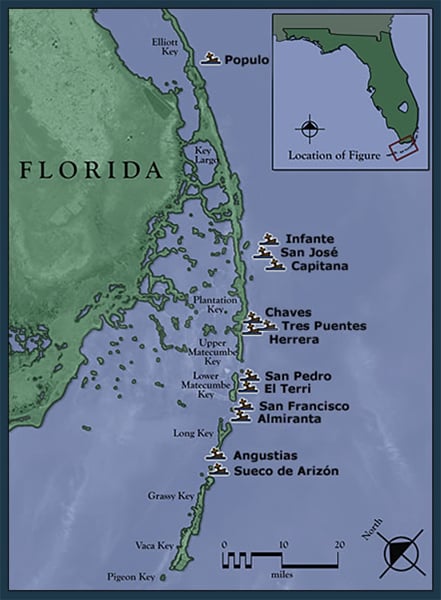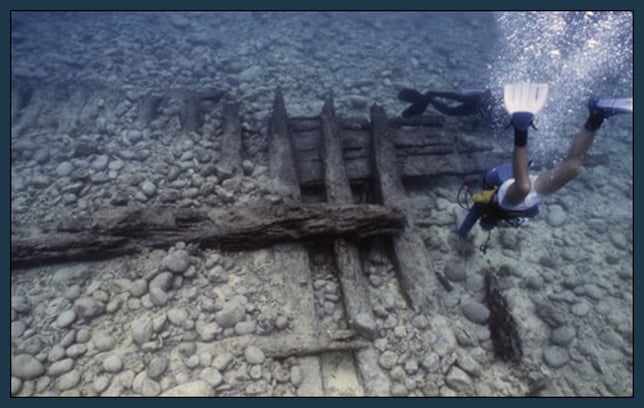
The MATE Spanish Galleon Ship Hunt
The Spanish Galleon Competition Kit is a stand-alone competition - the mission specifications, prop-build instructions, and all necessary documents for this mini-competition are here, free of charge. This is a competition that is NOT part of the MATE ROV Competition; we designed the Spanish Galleon competition for schools who want to build ROVs for a competition, but do not want to compete in the official MATE competition. If you would like to purchase the necessary props as part of a kit, you may do so via this link to the SeaMATE Store.
Mission Scenario
Ships have been sinking at sea since people first started to sail on the waters. Whether from carelessness, storms, or warfare, shipwrecks litter the bottom of the oceans, seas, lakes and rivers around the world. In the 17th and 18th century, major and minor European powers battled for economic and military power in the New World. In the Caribbean and Gulf of Mexico, ships plied the waters with raw products (sugar, gold, silver, tobacco, coffee, cotton, etc.) being sent to Europe or finished and manufactured goods coming in to the New World. Many of these ships never reached their destinations, being sunk by storms, after battle with enemy nations or pirates, or by simply running aground on unknown reefs. Only a few of the many ships lost at sea have been found, and new discoveries of shipwrecks, ancient or modern, are being discovered every year.

Known shipwrecks of Spanish Galleons
While surveying a deep-water reef in the Caribbean Sea, researchers discovered a new shipwreck. Initial surveys indicate that the wreck is that of a Spanish Galleon, but the research ship did not have the equipment and tools to do a proper search and identification of the newly discovered shipwreck. This is where you come in. Your ROV has been hired to identify the unknown shipwreck while also preserving the deep-water reef habitat.

The Spanish Galleon Infante; lost in a hurricane off Key Largo, Florida in 1733
This is where your work begins. Your ROV has been hired to complete the following tasks:
- Move corals out of the work area
- Collect sea urchins for scientific research
- Recover a cannon with the build date of the ship stamped on it and recover a platter witht he ship's home port printed on it
- Use the build date and home port to identify the Spanish Galleon
- Retrieve some trash (aluminum cans) that litter the area
Mission Tasks:
Scientific Investigation
Your company is tasked with preserving corals found around the worksite. Scientists have indicated three coral colonies that must be removed from the work area and transplanted into a safe, designated location.
Scientists have also observed a number of sea urchins located on the reef. Unlike the predatory sea urchins that destroy the coral reefs in the South Pacific, in the Caribbean and Gulf of Mexico, the urchins are beneficial to the coral reefs, consuming algae that hinders the growth of corals on the reef. The scientists have asked you to collect two of these sea urchins for further genetic analysis.
The scientific conservation task involves the following steps:
- Recovering and transplanting three corals into the designated area - 10 points each, 30 points total
- Recovering and returning two sea urchins to the surface - 10 points each, 20 points total
Ship Hunt
Your company is tasked with exploring and identifying a newly discovered, unknown Spanish galleon on the nearby reef. In order to identify the wreck, your company must determine 1) the construction date of the ship and 2) its home port. A list of nine potential galleons is provided at the mission station.
A cannon and a ceramic dinner platter are located within the mission area that represents the shipwreck. The cannon has the construction date of the ship stamped on it. The name of the galleon’s home port is written on the ceramic dinner platter. The three possible home ports for the galleon are cities of Bilbao, Cartagena, or Cadiz, all of which are located in Spain.
The ship hunt task involves the following steps:
- Recovering and returning the cannon to the surface - 20 points.
- Recovering and returning the ceramic dinner platter to the surface - 20 points
- Identifying the shipwreck - 10 points
Conservation
Your company is tasked with removing trash from the galleon wreck site.
The trash consists of four simulated aluminum cans scattered around the mission area. You have been tasked with retrieving this debris and returning it to the surface.
The conservation task involves the following steps:
- Recovering four cans and returning them to the surface - 5 points each, up to 20 points total
Mission Notes
The scientific investigation, ship hunt and conservation tasks may be done in any order and teams may alternate between the various steps. Teams may come to the surface as many times as needed to complete the tasks.
To receive points for recovering an item from the work area or sea floor (corals, urchins, cannon, platter or aluminum cans), teams must have the item under control of the ROV and no longer in contact with the pool bottom. Pushing an item along the bottom is not sufficient.
Once recovered, corals must be transplanted into a designated area. To receive points for transplanting the corals, the base of the coral must be completely within the designated area and no longer in contact with the ROV.
Once recovered, the urchins, cannon, platter and aluminum cans must be returned to the surface. To receive points, the item must be removed from the ROV and placed on the side of the pool or the ground.
When the cannon and the platter have been brought to the surface, teams must use the date stamped on the cannon and the home port city printed on the platter to identify the Spanish Galleon. Teams can use the Spanish galleon handbook to identify the wreck. A laminated copy of the Spanish Galleon Handbook will be available at the side of the pool for reference.
Spanish Galleon Mission Manual
Spanish Galleon Identification Guide
Spanish Galleon Build Instructions (with part numbers)
